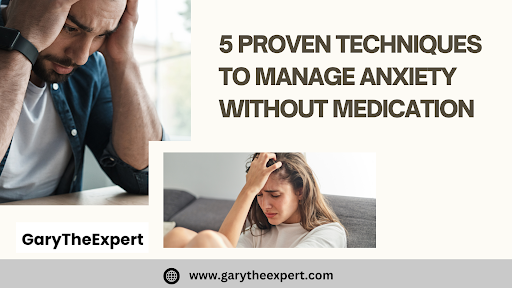5 Proven Techniques to Mange Anxiety Without Medication
Are you struggling with anxiety, and want to avoid medication with recovery? There are plenty of natural methods to manage anxiety in this blog we will cover highly effective ones. By incorporating simple practices into your daily routine, you can reduce the intensity of anxiety and regain control of your life.
In this blog, we’ll discuss five proven techniques on how to manage anxiety without the use of medication. You’ll learn how to overcome your anxiety and sharpen your tools, and these strategies are rooted in mindfulness, physical activity, and lastly uses of our thoughts. There will be real, long-term relief. While medication is a common treatment, many prefer a holistic approach to reducing anxiety. If you are new to anxiety management, don’t worry, there are many simple tips to improve your emotional home. Or maybe you’re looking for alternative solutions, then these 5 techniques can help you cultivate a calmer mind.
What we’ll cover is 5 tools for anxiety:
- Breathing Techniques
- Physical activity
- CBT for anxiety
- Journaling
- Meditation, and Yoga
1. Breathing Techniques
Anxiety often brings rapid breathing and or shallow breathing. Mindful breathing is interrupting the pattern of your anxiety. Today we will focus on box breathing.
How it works:
- Start with an inhale of 4 seconds.
- Hold for 4 seconds.
- Exhale for 4 seconds.
- Repeat at least 5 times.
Why it works:
In short and simple terms: It relaxes your nervous system.
2. Physical Exercise
Taken exercise is one of the best ways to reduce anxiety, and most undervalued. It doesn’t only improve physical health, it also has a direct effect to our mood. Engaging with exercise consistently you will realise different hormones, like endorphin, or serotonin, which to our knowledge play a key role in our feelings.
It works because you train your system, your body, your temple to feel different emotions meaning anxiety is reduced and other emotions are experienced.
Start out with simple walking if you don’t exercise much, or set new goals if you do exercise much, or lastly, maybe try a different sport you can get a bite into. Something like boxing classes, jiu jitsu, or activities like mountain cycling can increase your threshold of anxiety, you hit a new level.
3. Cognitive Behavioural Therapy (CBT)
Something I’m known for on this site is CBT. CBT is one of the most effective therapies for anxiety, it teaches you how to identify your negative thought patterns, especially the unconscious sentences and beliefs we say to ourselves. The way we view something, like a past event can bring up certain emotions now. Good, bad, indifferent.
Steps you can take:
- Meditating can show you anxious thoughts that might come up regularly. From here sitting with the feeling at home and processing the emotion there, the impact will reduce elsewhere.
- Journaling is always a great way to process the emotions you’re having. You can see on paper, negative thoughts you’re keeping and causing distress.
Why it works:
Your mind and mine is beautiful, but not designed to make us everlasting happy, it’s suppose to keep us safe, anxiety keeps us safe. We must retrain our minds to not see everything as anxiety ridden. Thoughts create emotions, and that’s where emotions are being triggered. Getting to them root thoughts, you can skyrocket out of anxious feelings into excitement.
4. Journaling
Writing down your thoughts like mentioned is a great way to process your emotions. It’s a positive way to have emotional release. Journaling helps people reduce overthinking where anxiety usually stems from, and journalling helps you step outside of your mind and examine your thoughts objectively.
How to start:
- Create a daily practice, or weekly practice, 10-15 minutes to start.
- Write freely about your day, the anxiety, emotions in general.
- Use complete autopilot writing or prompt yourself with questions like, “what is I feeling anxious about today?”
Why it works:
Journaling helps externalise our worries, offers clarity to what is affecting us, and we gain a sense of control. It also acts as a long-term record for progress, or patterns. Therefore we can spot triggers, and help prevent next time.
5. Meditation and Yoga
Meditation and yoga are ancient practices that are gaining popularity more and more. There ability to calm the mind and reduce anxiety is amazing. Both help you focus on the present moment, easing overthinking and anxiety around your triggers.
Meditation for Anxiety Relief
- Find a quiet place to sit comfortably, and close your eyes.
- Focus on your breathing, bringing your attention back each time your mind wanders.
Your mind will wander, you will question if you’re doing it right, and the answer is, you are.
Yoga Practice for Stress Management
- Begin with beginner-friendly poses like Child’s Pose or Cat-Cow.
- Integrate a regular yoga practice (even 10–20 minutes a day) to stretch and release tension stored in the body.
Why it works:
Both practices reduce cortisol levels, a hormone responsible for stress. Meditation and yoga also teach mindfulness, which helps remain grounded. A strong feeling of contentment.
Conclusion:
Anxiety can feel overwhelming, but the above 5 techniques - Mindful breathing, physical exercise, CBT, journaling and meditation - offer powerful and medication-free way to mange it. Consistent practice of the methods above you can start to regain your emotional wellbeing.
The key is to find which resonates with you the most, which tool makes you feel the best about doing. Also remember regaining control of your emotions can take some time, with emotions, there are never a set time. There are only consistent progress or going backwards, never set in stone. Do what calls you to do. Spend time, and you will in time improve your emotional home.
